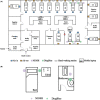SARS-CoV-2 environmental contamination associated with persistently infected COVID-19 patients
- PMID: 32578948
- PMCID: PMC7361718
- DOI: 10.1111/irv.12783
SARS-CoV-2 environmental contamination associated with persistently infected COVID-19 patients
Abstract
Background: Severe COVID-19 patients typically test positive for SARS-CoV-2 RNA for extended periods of time, even after recovery from severe disease. Due to the timeframe involved, these patients may have developed humoral immunity to SARS-CoV-2 while still testing positive for viral RNA in swabs. Data are lacking on exposure risks in these situations. Here, we studied SARS-CoV-2 environmental contamination in an ICU and an isolation ward caring for such COVID-19 patients.
Methods: We collected air and surface samples in a hospital caring for critical and severe COVID-19 cases from common areas and areas proximal to patients.
Results: Of the 218 ICU samples, an air sample contained SARS-CoV-2 RNA. Of the 182 isolation ward samples, nine contained SARS-CoV-2 RNA. These were collected from a facemask, the floor, mobile phones, and the air in the patient room and bathroom. Serum antibodies against SARS-CoV-2 were detected in these patients at the beginning of the study.
Conclusions: While there is a perception of increased risk in the ICU, our study demonstrates that isolation wards may pose greater risks to healthcare workers and exposure risks remain with clinically improved patients, weeks after their initial diagnoses. As these patients had serum antibodies, further studies may be warranted to study the utility of serum antibodies as a surrogate of viral clearance in allowing people to return to work. We recommend continued vigilance even with patients who appear to have recovered from COVID-19.
Keywords: COVID-19; SARS-CoV-2; coronavirus; intensive care unit; transmission.
© 2020 The Authors. Influenza and Other Respiratory Viruses published by John Wiley & Sons Ltd.
Figures



References
Publication types
MeSH terms
Substances
Grants and funding
LinkOut - more resources
Full Text Sources
Other Literature Sources
Research Materials
Miscellaneous

